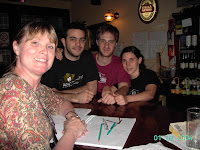
Tonight we met our patroness, Ana, the woman from whom we are renting the apartment. She stopped by to see how we were doing after just returing from the United States where she was visiting her two sons in Atlanta and Chicago.
.
We had a lovely discussion about the city and the country--the politics, the history. We shared a bottle of Malbec and she helped us study for tomorrow´s Spanish final exam.
.She is a lovely and intelligent woman with whom we spend a very pleasant evening. I hope we see more of her. She is an excellent speaker of English and a very patient tutor of Spanish. Spending the evening speaking Spanish with her was a very different experience than our three-hour classes at UBA where--let´s just say it´s not always pleasant and relaxed.
a very different experience than our three-hour classes at UBA where--let´s just say it´s not always pleasant and relaxed.
 a very different experience than our three-hour classes at UBA where--let´s just say it´s not always pleasant and relaxed.
a very different experience than our three-hour classes at UBA where--let´s just say it´s not always pleasant and relaxed..
ON to the post office
.
We had a very different experience today that was actually not as bad as I had been told it would be. Our daughter, Kristin, sent us a package from the USA containing a few books and a left shoe--ask Helen to explain that one.
.
They could have delivered the package to our apartment, but, instead, sent us a notice to go to Retiero and pick it up there. When you enter, you take a number. That number tells you the order in which the clerk will process your request. About ten minutes later, they called our number and I presented the notice and my passport. I signed the form and was handed a part of the form I had been delivered that contained a 5-digit number. I was told to go and wait in the next room--the one pictured here. Everybody here had already been there for a while.
.
After a few moments, I caught on that they were going to call my number and I was to walk through a mysterious door. Last night, I asked my expat friend, Pete, the owner of Shoeless Joe´s, why this was necessary. He told me it was a shakedown. They were going to open the package, look inside, and determine what import tax I should pay on the contents.
.
I saw a young couple sitting in the row in front of us reading the Buenos Aires Herald (the English language newspaper). "Excuse me," I said, "Have you guys done this before." Apparently, I startled them--the combination of an American accent and someone actually approaching them in a public place and NOT asking for money was a bit offputting.
.
They told me that this was their second trip to the international package facility. The last time, they waited four hours. I sent Helen home in a cab and prepared to wait it out solo. I could not believe my ears, and doubted my ability to understand large numbers in Spanish, so when I thought I heard my number called, I ignored it--after all, the other North Americans had already been there an hour and they had not been called. About ten minutes later, I hear the number again followed by "Kehn Kehrr." OK, so I guess it was me. I went through the secret door to find what looks very much like an American post office--only older and dirtier. The man took my number and got my package. He opened it in front of me, rifled through it, taped it back up, and sent me on my way. After that was a rather embarrassing exchange with the next man at the final desk who, as hard as he tried, could not make me understand where I was to PRINT my name adn where I was to SIGN my name. I did it wrong. He didn´t give me a hard time.
All-in-all, it was not too bad--by Argentine standards. USAmericans would be screamming and calling their congressman over having to wait at all for a package, but I was out in about an hour and didn´t have to pay any import tax. No shakedown.
I must be doing something right.






















 comes the law, then you cheat). I was just trying to fit in.
comes the law, then you cheat). I was just trying to fit in.






























